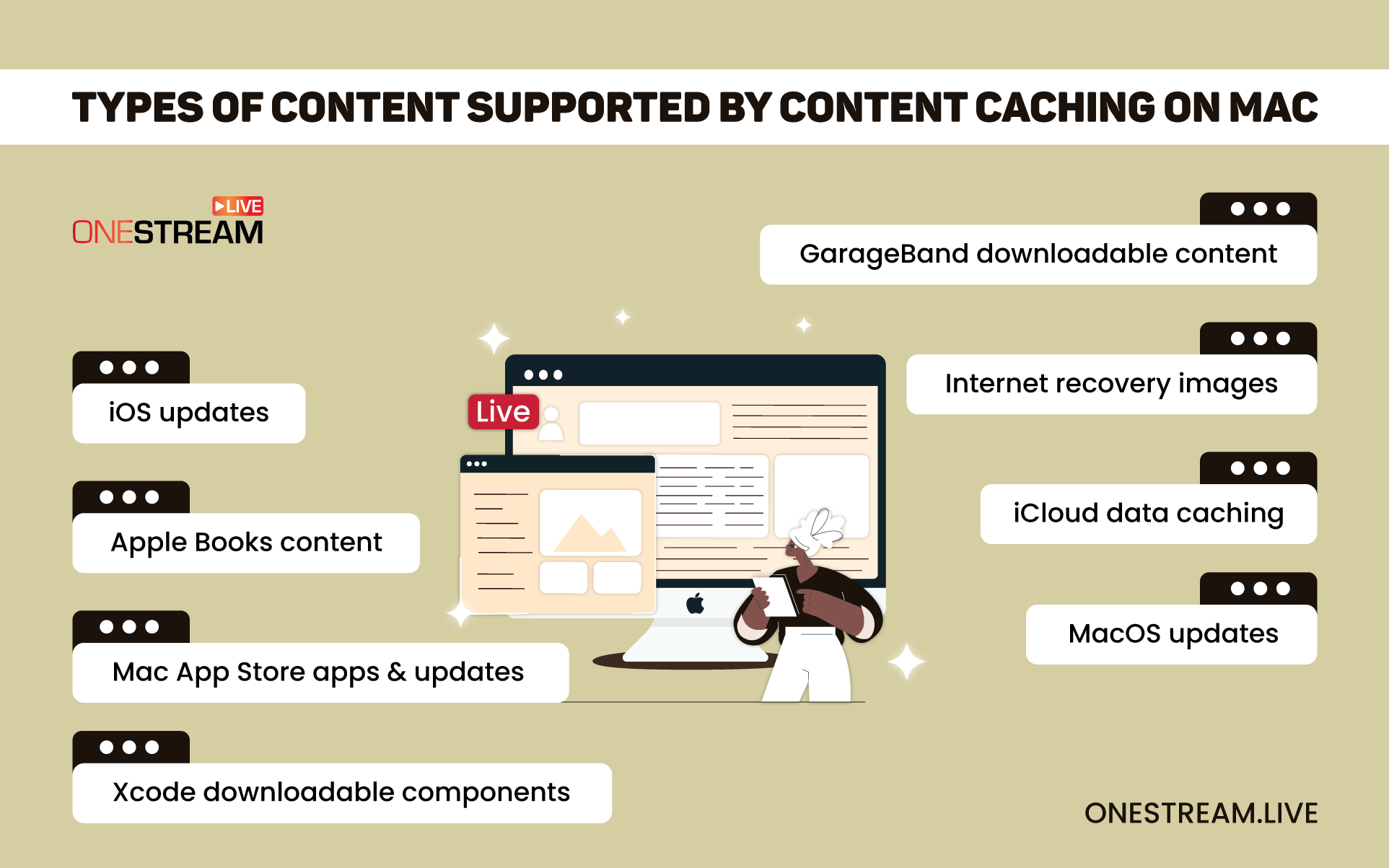Do you have more than one Apple device and find it quite challenging to update them? Well, you are not alone. Sometimes, it gets annoying when you are trying to download an update or an app on your MacBook, considering the time it takes.
Ideally, getting the latest macOS updates on your Mac takes longer. It is even worse if you have to download the same multi-gigabyte files for more than one Mac because it saturates your bandwidth.
One solution most Mac users turn to is content caching. This feature of macOS allows your device to retain copies of every installer and updater you download to save time and bandwidth.
In this blog post, we are going to explore content caching on Mac, how it works, and recommendations on how to get the most out of it.
What is Content Caching on Mac?
Content caching is a macOS service designed by Apple to expedite downloads and reduce internet load for individuals and organizations using Apple devices. It operates akin to sharing files among friends.
A copy of downloaded content is stored locally to facilitate faster subsequent downloads within the same network.
Primarily utilized in networks with numerous Apple devices, content caching on Mac stores copies of downloaded apps, updates, iCloud documents, and other supported content within the Mac itself.
You can use content caching in various network environments, including network address translation (NAT) for the content cache and all connected devices. Content caching on Mac is also compatible with networks comprising publicly routable IP addresses.
Here are the key network environments where content caching can be safely utilized:
- Networks with NAT for both the content cache and connected devices. NAT helps to translate private IP addresses into public ones, and content caching remains compatible within such environments.
- Content caching can also function optimally on Networks with Publicly Routable IP Addresses. This applies whether devices within the network operate on public IP addresses or use NAT. You can check a Mac’s public IP address with an IP lookup tool.
- You can also optionally employ content caching for devices tethered to a Mac. This works in situations where multiple devices are provisioned simultaneously using Apple Configurator.
How Does It Works
Enabling content caching on your Mac keeps local copies of items, accelerating downloads for connected devices within the network. Once activated, content caching on a Mac retains copies of supported content that local networked devices (clients) download.
For instance, when the first client in your network downloads an app from the App Store, the content cache preserves a copy of that app. Subsequently, when another device within the network seeks to download the same app, it retrieves it from the content cache on the Mac.
This saves the time it would have taken to fetch it anew from the App Store. This method dramatically hastens download speeds for subsequent clients, leveraging the faster local network connection while preserving internet bandwidth.
Types of Content Supported by Content Caching on Mac
Various types of content are compatible with content caching on macOS, enabling efficient caching for a range of software commonly used in work environments. They include:
- iOS updates
- MacOS updates
- Internet recovery images (from macOS 10.13.5 onwards)
- Xcode downloadable components (requires Xcode 10.2 or later)
- iCloud data caching (photos and documents)
- Mac App Store apps and updates
- Apple Books content
- GarageBand downloadable content
How to Set Up Content Caching on Mac
To ensure efficient performance, you need to adhere to specific essentials when setting up a content cache within your network. Here are the prerequisites you should consider:
- Have a dedicated Mac within your network as the content cache hub. Ensure it is consistently powered on to effectively serve other devices in the network.
- Ensure the designated Mac has an uninterrupted and reliable internet connection. A stable internet connection is essential for efficient content caching.
- The chosen Mac must have a substantial amount of free space allocated for content caching purposes. You can always clear the cache on Mac to get more space for storing the cached content. Additionally, ensure other system features are working properly – like dictation, which can occasionally malfunction due to system misconfigurations or updates. If you’re experiencing dictation problems, here’s how to troubleshoot them effectively.
- Verify that the Mac intended for content caching runs on macOS 10.13 (High Sierra) or a later version. Compatibility with the required macOS version ensures optimal functioning of the content caching feature.
Apple recommends connecting the content cache to the network using an Ethernet connection rather than Wi-Fi for enhanced performance. You should do this, especially during heavy loads, as Ethernet tends to offer more reliable and consistent speeds.
On your Mac, you can easily turn on and off content caching with ease. You can also select a volume, share the cached content with other Apple devices, set the size, or even delete all cached content. Here are key simple steps to set up a content cache in your network:
- Select the Content Cache Mac.
- Navigate to the Sharing Preferences tab within System Preferences on the chosen Mac.
- Locate and select the Content Caching option.
- Upon selection, a tab will appear, allowing you to choose the types of content to cache and decide whether to share the internet connection.
Once content caching preferences are set, click on Options at the bottom of the page. You can specify the cache volume and size or reset an existing cache. For more configurations, utilize the hidden Advanced Options by pressing the Option key on the keyboard.
This unlocks further settings, including cache size adjustments, client preferences, and configurations for multiple content caches within the same network (Peers and Parents settings).
After configuring the settings, return to the Sharing Preferences tab and check the box beside the Content Caching option. Click done and restart all client devices. This ensures swift acknowledgment of alterations made to the content cache settings.
Best Practices and Recommendations for Content Caching on Mac
You can configure content on your Mac manually using Content Caching preferences. This is accessible in the Sharing preferences in System Preferences on macOS. However, there are a few recommendations before getting started.
Hardware Recommendations
Before setting content caching on your Mac, ensure you have the required hardware recommendations. This includes a Gigabit Ethernet—if possible, a 10GB Ethernet. Ensure your device also has at least 16 GB RAM and adequate space for cache storage.
The two key factors behind content caching performance on Mac are connectivity and hardware configurations. That is why Apple recommends using a good Ethernet cable for a high-speed and high-bandwidth connection.
Manage Inter-Site Caching Traffic
One best practice in the content caching process on your Mac is to manage the inter-site caching traffic. You should aim to regulate the data flow between multiple content caches for an efficient retrieval process.
It is a recommended practice that can greatly reduce congestion and optimize data transfer between caches.
Analyzing Content Cache Performance
Ensure you analyze content caching performance by checking the processor usage on your Mac. The Activity Monitor will help you check content cache activity and take the necessary steps depending on the performance.
For example, if the processor shows high usage, your content cache works optimally. However, if it is struggling or running regularly, it might be time to expand by adding more content caches to lighten the load.
Specify a Transmission Control Protocol (TCP) Port for Caching
Using a dedicated TCP port for caching, you streamline data transmission and reception between connected Apple devices and the content cache. This results in a more standardized and organized approach to content caching operations while enhancing the entire process.
Final Thoughts
Content caching on Mac reduces the load on the internet and makes downloads on devices even faster. As a Mac user, the trick lies in finding the best practices and adhering to Apple’s set recommendations.
Taking these simple steps not only optimizes the performance of content caching on your Mac but also assures you of a streamlined and secure caching environment. In the end, you will enjoy a more efficient content delivery and retrieval process within your network.
OneStream Live is a cloud-based live streaming solution to create, schedule, and multistream professional-looking live streams across 45+ social media platforms and the web simultaneously. For content-related queries and feedback, write to us at [email protected]. You’re also welcome to Write for Us!










